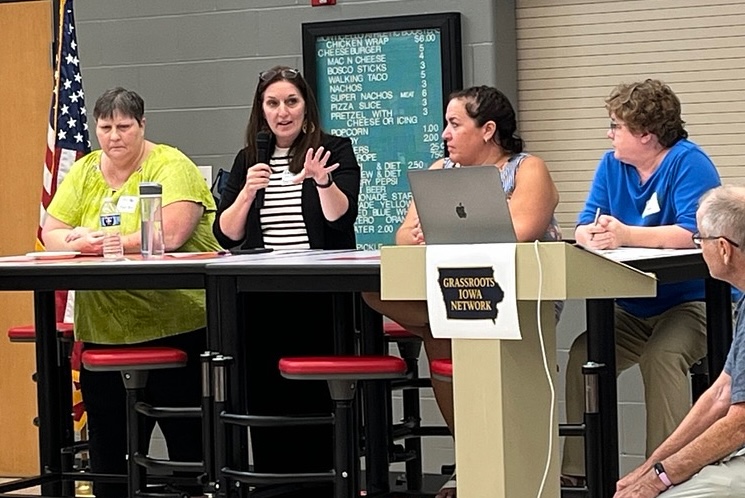Amy Adams is partnerships director for Progress Iowa and has worked with a variety of Iowa-based grassroots organizations for the past eight years. She is a wife and mother of three living in rural northeast Iowa.
In today’s digital world, it can be easy to feel like our voices get lost in the noise. But one simple, powerful tool still cuts through and makes a real impact: the letter to the editor.
For the past seven years at Progress Iowa, we’ve worked to support and amplify the voices of Iowans through storytelling. And one of the most powerful and easy ways to speak up is through a letter to the editor. Letter writers lift up the issues that matter most, from education and reproductive freedom to climate justice and fair taxes.
Why write a letter to the editor? Because it works. The opinion section is one of the most-read parts of any newspaper, both in print and online. It’s a free way to educate your neighbors, influence public opinion, and show lawmakers what real Iowans care about. Political staffers and elected officials pay attention to local papers; they’re listening, whether we’re calling for change or standing up for progress.
Who can write a letter to the editor? You. No fancy titles or policy expertise required. Just your experience, your values, and your voice. If you’ve lived it, that’s expertise.
What makes a good letter? Effective letters are grounded in shared values and driven by clear calls to action. Start by naming what you believe in: whether it’s access to affordable health care, strong public schools, or clean water for every community. Then name the problem, or identify the villain: who or what is standing in the way of that value? Add a personal example or real-world impact to bring your point home. Your lived experience is your expertise. Our stories connect us, and they persuade us.
Avoid getting caught up in facts and figures. A couple of those can be handy, but the real-world impacts of the issue you seek to address are what readers will remember. Finally, share a solution and tell readers what they can do next. Is there a call to action? Tell readers what to do.
Here’s a basic framework to follow:
- Lead with a value.
- Name the problem/identify the villain.
- Give an example or personal story.
- Offer a solution or call to action.
Letters are most effective when they’re timely and concise, usually around 150-200 words. Know your local paper’s submission guidelines, and if your letter isn’t published within two weeks, follow up with the editor. Get to know your local newspaper editors. Support local news. Our small and mid-sized towns are fortunate to have local newspapers.
Your voice, your story, and your ideas matter—because when we speak together, we’re stronger.
Amy Adams, Progress Iowa, amy@progressiowa.org


5 Comments
Amy Offers Excellent Advice
I join Amy to encourage the Bleeding Heartland community to write letters to the editor to inform and educate their communities.
Last month I sent letters to six newspapers in my area to warn about the implications of the then proposed Medicaid cuts. All the papers are based in deeply conservative communities. Four papers printed my letter.
Many people who share thoughts in the Bleeding Heartland comment section offer excellent insights and knowledge about a range of important topics.
Consider an occasional letter to the editor. Our community members need to see there are local citizens that oppose harmful policies being pursued on the state and national levels.
Bill Bumgarner Wed 30 Jul 8:49 AM
always grateful when folks like Chris Jones try and inject some truth and justice into
our local news with their letters but what is the evidence of this supposed effectiveness in changing public opinion and governance?
https://www.desmoinesregister.com/story/opinion/readers/2025/07/23/iowa-water-quality-big-ag-cafos-industry-pollution-nitrates/85333828007/
dirkiniowacity Wed 30 Jul 11:56 AM
Letters to the editor are just one part of the broader messaging ecosystem
To be effective, we need to amplify similar messages across all platforms, print, digital, and in-person. We can’t afford to abandon any channel. Supporting our local newspapers and local writers is especially critical in mid- to small-sized towns, where these outlets remain trusted sources of information. Staying connected across all of these spaces allows us to be a constant current of progressive messaging that reaches people wherever they are.
Amy Adams Thu 31 Jul 12:33 PM
Good letters to the editor...
…help some of us feel more connected to other Iowans and more determined to make things better. It can be heartening to feel kinship with others who share the same values. Obviously good letters can’t solve the problems. But they can be sources of emotional uplift as well as information, and in 2025 Iowa, that matters.
PrairieFan Thu 31 Jul 1:14 PM
so no real evidence that they sway elected officials
or move the public our way? I mean I’m all for preaching to the choir but if that’s what this is about let’s just call it that. I don’t see much evidence that elected officials from either party are particularly responsive to changing what they’re up to in response to voters so would welcome any success stories along these lines.
dirkiniowacity Thu 31 Jul 2:50 PM